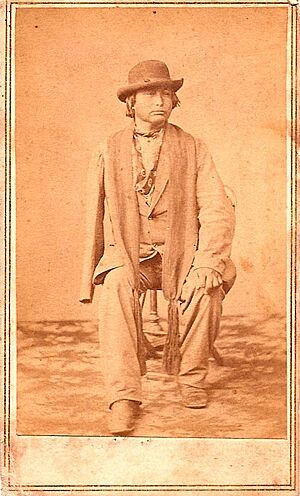Joseph James and Joseph James Jr. facts for kids

Joseph James is the name of two important interpreters from the 1800s. They helped people from the Kaw and Osage tribes talk with French and American settlers. Both men were often called "Joe Jim" or "Jojim." They lived in what is now Kansas and Indian Territory (which later became Oklahoma).
Contents
Who Was Joe Jim Sr.?
Joe Jim Sr. was likely born in the 1790s. His birthplace was an Osage town in what is now Vernon County, Missouri. He was probably the son of a French trader and an Osage woman.
Life with the Kaw Tribe
Around 1815, Joe Jim Sr. began living with the Kaw tribe. They lived along the Kansas River in the area that would become the state of Kansas. Joe Jim Sr. married a Kaw woman named Wyhesee. She was born around 1802 and was the daughter of a Kaw chief named White Plume. Because of this marriage, Joe Jim Sr. became a very important person in the tribe.
In 1825, Joe Jim Sr. signed a treaty. This agreement gave Kaw land to the United States government. He signed it using his Kaw name, Ky-he-ga-shin-ga, which means "Little Chief."
Working as an Interpreter
Joe Jim Sr. was very good at languages. He could speak English, French, Kaw (Kanza), and Osage. The Kaw and Osage languages are very similar. Around 1829, he started working for the U.S. government as an interpreter.
In 1830, he guided a group exploring western Kansas. This group was led by a missionary named Isaac McCoy. McCoy usually criticized people, but he spoke highly of Joe Jim Sr. The last time we find a record of Joe Jim Sr. is in 1837. He was still working as an interpreter for the U.S. government then.
Who Was Joe Jim Jr.?
Joe Jim Jr. was born around 1820. He was born in a place called "Big Bottom" along the Kansas River. His tombstone says he was born in 1814, but other records suggest he was born later. He likely could not read or write.
Adventures and Challenges
In 1846 and 1847, during the Mexican–American War, Joe Jim Jr. helped move cattle. He and another man, Peter Revard, drove a herd of cattle from Kansas to New Mexico. The cattle were needed to feed American soldiers. Joe Jim Jr. also worked as a teamster, driving wagons during a military campaign against the Navajos.
On his way back to Kansas, he was in a wagon train that was attacked by Comanche warriors. Two American soldiers died in the attack, but Joe Jim Jr. survived.
In the 1850s, Joe Jim Jr. had to have his arm removed because of "poisoning." This injury made it hard for him to continue his active life.
A Bridge Between Worlds
In 1858, Joe Jim Jr. became an interpreter for the U.S. government. After that, he was a main contact person between White settlers and the Kaw tribe. He lived in both worlds but never fully belonged to either. One of the Indian Agents he worked for was Hiram Warner Farnsworth.
In 1859, Joe Jim Jr. shared information with Lewis Henry Morgan, a famous researcher of cultures. Morgan wrote about him: "He is half French and half Kaw... and bright and intelligent." (Actually, Joe Jim Jr. was less than one-fourth French and mostly Kaw and Osage). Morgan also noted, "He is married to a Potawatomi woman, and lives in a good log house on the bank of the beautiful Kansas River."
Joe Jim Jr.'s wife was Margaret Curley. She was a full-blooded Potawatomi Indian. The Potawatomi people had been forced by the U.S. government to move to Kansas from the Ohio River valley in the 1830s.
Naming Topeka
Joe Jim Jr. is believed to have named Topeka, Kansas. When White settlers asked him the name of the place, he said "Topeka." He explained that it meant "a good place to grow potatoes." He probably meant the prairie turnip, which was a common plant there, rather than the regular potato.
In 1867, Joe Jim Jr. traveled to Washington, D.C. with a group of Kaw leaders. This group was led by Chief Al-le-ga-wa-ho. The Kaw tribe was shrinking quickly because White settlers were taking over their lands. They wanted a new reservation in the Indian Territory (now Oklahoma) where they could live without settlers.
The "Battle Royal"
Joe Jim Jr. was part of a famous event in the West. On June 3, 1868, about 100 Cheyenne warriors came to the Kaw reservation near Council Grove, Kansas. The Kaw men went out to meet them. For four hours, the two tribes put on a show that was called a "battle royal." The Cheyenne then left, taking a few stolen horses and some coffee and sugar given by merchants from Council Grove. No one was seriously hurt on either side.
During this event, Joe Jim Jr. rode his horse 60 miles to Topeka. He went to tell the governor that the Cheyenne were attacking and to ask for help. With him on the ride was his eight-year-old nephew, "Indian Charley." This boy later became Charles Curtis, who was a Vice President of the United States.
Moving to Oklahoma
By June 4, 1873, the Kaw people had greatly decreased in number. Diseases and fighting had reduced their population from about 1,500 to only 500 people. They packed their belongings and moved to a new reservation in what is now Kay County, Oklahoma. Their numbers continued to fall, reaching about 200 people by 1890.
Joe Jim Jr. and his wife Margaret built a home on the east bank of the Arkansas River. It was just south of the Kansas border. He passed away on September 21, 1898. He was the oldest of the Kaw Indians at that time. He was buried in the Washunga cemetery, which is now in Newkirk, Oklahoma.
Images for kids
-
Joseph James Jr. in 1867, photo by Hiram Warner Farnsworth


